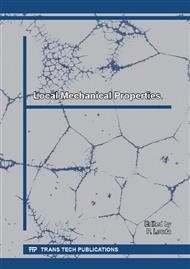[1]
Němeček, J., Králík, V., Vondřejc, J., Micromechanical analysis of heterogeneous structural materials, Cem Concr Comp 36 (2013), 85-92.
DOI: 10.1016/j.cemconcomp.2012.06.015
Google Scholar
[2]
da Silva, W. R. L.; Nemecek, J.; Stemberk, P., Methodology for nanoindentation-assisted prediction of macroscale elastic properties of high performance cementitious composites, Cem Concr Comp 45 (2014), 57-68.
DOI: 10.1016/j.cemconcomp.2013.09.013
Google Scholar
[3]
Minster, J.; Blahova, O.; Lukes, J.; et al., Time-dependent mechanical characteristics measured through the use of a microindentation technique, Mech Time-Dep Mat 14 (3) (2010), 243-251.
DOI: 10.1007/s11043-009-9105-x
Google Scholar
[4]
Cook, R.F., Pharr, G.M., Direct observation and analysis of indentation cracking in glasses and ceramics. J. Am. Ceram. Soc. 73 (1990), 787–817.
DOI: 10.1111/j.1151-2916.1990.tb05119.x
Google Scholar
[5]
Lawn, B.R., Evans, A.G., Marshall, D.B., Elastic/plastic indentation damage in ceramics: the median/radial crack system. J. Am. Ceram. Soc. 63 (1980), 574–581.
DOI: 10.1111/j.1151-2916.1980.tb10768.x
Google Scholar
[6]
Chen, J., Bull, S.J. Indentation fracture and toughness assessment for thin optical coatings on glass. J. Phys. D-Appl. Phys. 40 (2007), 5401–5417.
DOI: 10.1088/0022-3727/40/18/s01
Google Scholar
[7]
Li, X., Diao, D., Bhushan, B., Fracture mechanisms of thin amorphous carbon films in nanoindentation. Acta Mater 45(11) (1997)4453–4461.
DOI: 10.1016/s1359-6454(97)00143-2
Google Scholar
[8]
Jung, YG., Pajares, A., Banerjee, R., Lawn, BR., Strength of silicon, sapphire in the subthreshold flaw and glass region, Acta Mater 52 (2004) 3459.
DOI: 10.1016/j.actamat.2004.03.043
Google Scholar
[9]
Field, JS., Swain, MV., Dukino, RD., Determination of fracture toughness from the extra penetration produced by indentation-induced pop-in. J. Mater. Res. 18 (2003) 1412.
DOI: 10.1557/jmr.2003.0194
Google Scholar
[10]
Cheng, Y.T., Li, Z.Y., Cheng, C.M., Scaling relationships for indentation measurements, Philos. Mag. A 82 (2002), 1821–1829.
Google Scholar
[11]
Taha, RM., et al., Fracture toughness of hydrated cement paste using nanoindentation, Fracture Mechanics of Concrete and Concrete Structures - Recent Advances in Fracture Mechanics of Concrete - B. H. Oh, et al. (eds), (2010).
DOI: 10.21012/fc9.184
Google Scholar


